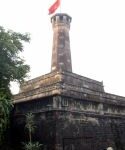Malacca or Melaka seems to be a fit place to end our stay in Malaysia, which bills itself as “Truly Asia.”
An old city at the southern entrance to the Straits of Malacca, through which pass over half of the shipping of the world, Malacca traces its history back to the 13th century or so, when an Indonesia prince (the connections between Indonesia and Malaysia are pretty strong even today; Bahasa is spoken in both countries, both are Muslim, and Sumatra, one of the over 2,000 islands that constitutes Indonesia, is 1-½ hours away by ferry on the other side of the straits) came here and had his dogs outfoxed (that sounds wrong) by a mouse deer, a small and now endangered species, under a Malacca tree. The sultan built a dynasty that lasted until 1513, when the Portuguese wrested away control of the city, beginning several centuries of Portuguese rule. The famous Cheng Ho, featured occasionally on the History Channel, visited here, and has a small corner in the history museum. There’s a rebuilt Istana (palace) of the sultan, which I can see from the window in my hotel, but Malacca is one of the four states in Malaysia now with no sultan.
Notable Portuguese were the Duke of Albuquerque, who was the second governor, and Francis Xavier, the Jesuit who was instrumental in bringing Catholicism to Asia. The priest was in fact buried in Malacca for 9 months, but was finally interred in Goa. Although the Portuguese rule ended centuries ago, there’s still a gate from the old fort, a bastion rebuilt (as part of the push for tourism), and a church on top of a hill that’s hollow and roofless, but picturesque, rather like its counterpart in Macau, also Portuguese. On a cruise on the Malacca River, the guide explained that his heritage was partly Portuguese, and there are descendants still in town.
The next stage marked the showdown for supremacy in colonial Asia between the Dutch and the British. The Dutch evicted the Portuguese, and built their own church, their own statehouse, and several other buildings that remain today, characterized (and standing out because of it) by large windows; the philosophy was that air could circulate better.
Finally, with the British already established at Singapore and Penang, the Dutch in 1824 exchanged Malacca for British possessions in what was becoming the Dutch East Indies, and Malacca became part of the Straits Settlements until 1947 (with the exception of World War II, when it was part of the Japanese empire); the British Club in town was where independence was proclaimed.
All periods are represented, which is to say, Malacca is an historian’s treat. From the Portuguese period, the church and fort; from the Dutch period, the red brick Stadthuys and the Church; from the British period some stately mansions (including the Majestic Hotel, a colonial bungalow that when David and I stayed here in 1997—in it—was the cheapest hotel in town; today, after extensive and expensive restoration, it is the most pricey hotel in town; glad we stayed in it when we did!)
I was heartened to learn that Malacca and Penang acquired UNESCO grants to preserve the heritage, and we were able to see some of the results: the area around the waterfront is being rehabilitated and renovated, and the houses already completed will certainly do as much for the important tourist dollars as the malls that are otherwise omnipresent in the bigger Malaysian cities. There was a Carrefour in the three-story mall across from our hotel, located in what was a hawker area when David and I visited here in 1997. Tourism has come to replace trade; the once prosperous harbor has silted up, replaced by Penang to the north, and more impressively, the city of lions (Singapore) to the south.
Of course, the foreign and colonial patina was marked, but the dominant population then as now was not foreigners, and that’s one other thing that makes Malacca attractive to me. There’s an old Chinese area in the town that has become a lot hokier than I remembered. On the boat ride, we saw an all-Malay area. Of course, there’s an Indian section, too. As befits a country that is 60% Malay, around 30-35% Chinese and 10% other (mostly Indian), all areas are visible and obvious.
The official line is that Malaysia is a model of peaceful mixing of races, one the world should emulate. We heard the story time after time, and the message is certainly true. As I’ve noted, the “mixing” isn’t as thorough as in the United States, though. Malays get favors in government jobs and education and in financing from banks; Chinese have a strong hold on business; Indians seem to do a lot of the service jobs. And the country has had a troubled history of race relations in the 1960s especially.
It does enjoy some wonderful natural scenery, even from the train, where there were broad plantations of rubber and palm oil. Then, there’s a whole side of the Peninsular Malaysia we did not get to—Muslim sultanates and spectacular beaches that you can see on the Travel Channel at least once a week. The country has at least one big advantage in attracting tourists from the Middle East—it’s proudly (but secularly) Muslim, and the obvious efforts that Mahathir made to replace the British administrative buildings with a distinctly Malay appearance is noted and noteworthy. Like many of the developing countries, it is heavily dependant on spending by the developed world. I found out, for example, that the Dell factory we visited has gone from 7 lines to 3. Even Singapore reported a first quarter decline of 7.8% this week.
Perhaps that’s one reason the cities have so many malls, and such spectacular ones. So many, indeed, that I’m tempted to call the country Mallasia.
We spent all day on the train getting to Singapore, where we’re going to spend a few days.
Best wishes for a wonderful weekend.































